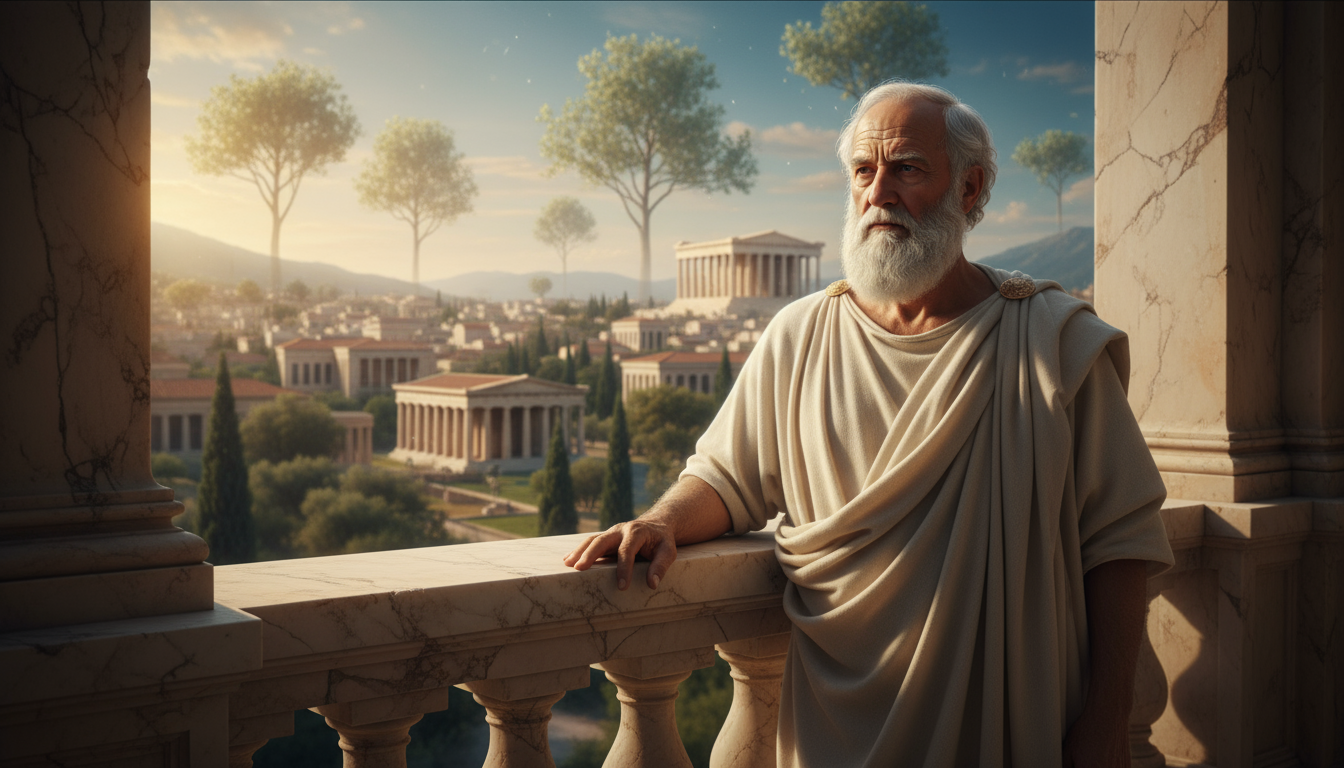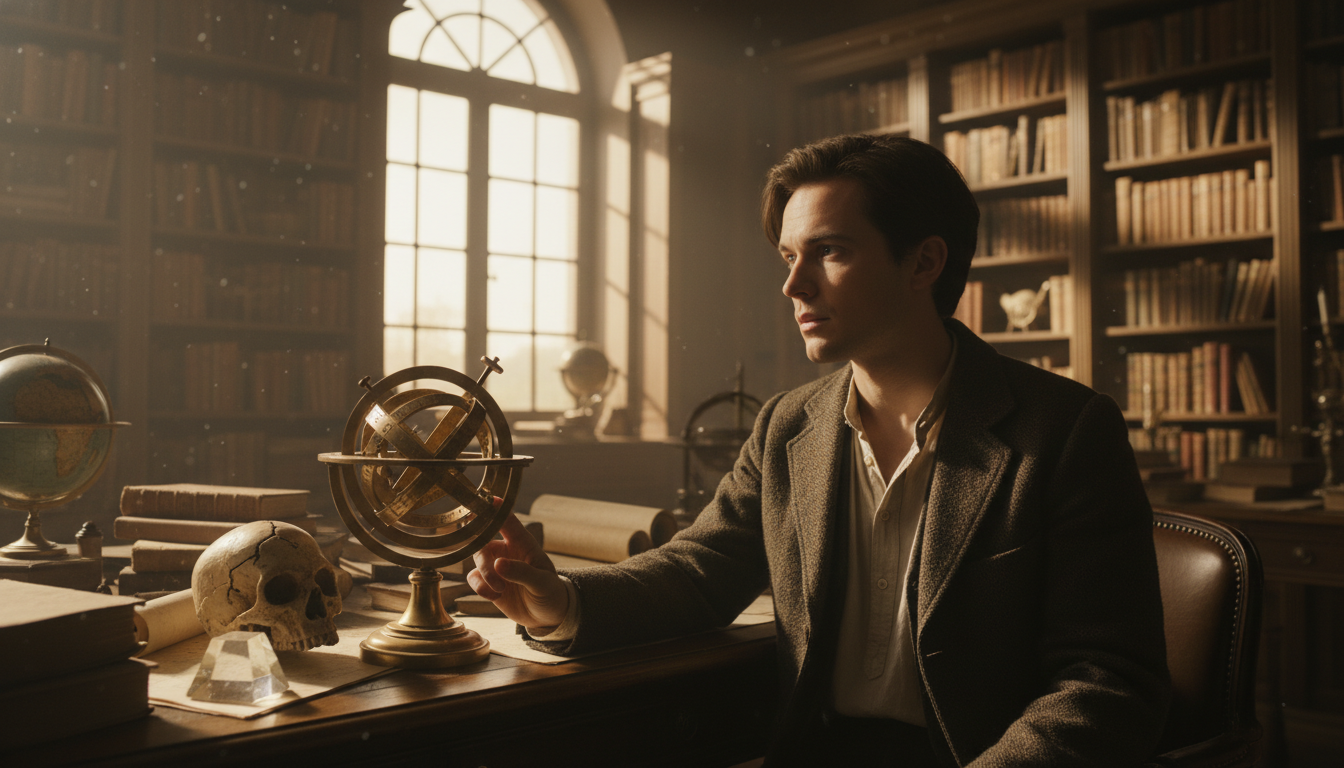Have you ever wondered if there’s a perfect, ideal version of everything you see and experience? Plato’s Theory of Forms confronts this very idea, suggesting the physical world you perceive is not the real world, but merely a shadow of a higher, more genuine reality. He argued that beyond your senses lies a realm of perfect, eternal, and unchanging blueprints, which he called “Forms” or “Ideas.” Every object in our world, from a simple chair to a complex concept like justice, is just an imperfect copy of its corresponding perfect Form.
Understanding this distinction is foundational to Western philosophy and the quest for true knowledge. Plato developed this theory to provide a stable basis for concepts that seem to change from person to person, like beauty or goodness. By proposing that a perfect, singular Form of Beauty exists, he created an objective standard against which all beautiful things in our world could be measured. Exploring these Forms is the key to a deeper level of understanding, helping you move beyond mere opinion to grasp the nature of reality itself.
Key Takeaways
-
Plato’s Theory of Forms posits that the physical world we perceive is not the true reality, but an imperfect shadow of a higher, non-physical realm of perfect ‘Forms’ or ‘Ideas’.
-
Reality is divided into two realms: the changing, sensory world of appearances where we only have opinions, and the eternal, intelligible world of Forms, which is the source of true knowledge.
-
Forms are the perfect, unchanging blueprints for all objects and concepts, like Justice or Beauty, and can only be grasped through intellect and reason, not the physical senses.
-
The theory’s main goal is to provide a stable, objective foundation for knowledge, creating an absolute standard for concepts that seem subjective or in constant flux.
-
The Allegory of the Cave illustrates this theory, depicting unenlightened humans as prisoners mistaking shadows for reality, while the philosopher’s journey is an ascent to the true knowledge of the Forms.
-
This ancient idea remains relevant by encouraging us to look beyond fleeting appearances to understand the perfect ideals that give meaning to concepts like justice, beauty, and purpose.
Introduction: What If Your World Is a Copy
Imagine that every beautiful thing you have ever seen, such as a sunset, a painting, or a person, is just a flawed imitation of a single, perfect concept of “Beauty.” This startling idea is the gateway to Plato’s Theory of Forms, a philosophy that challenges you to question the very nature of your reality. He proposed that the physical world you experience through your senses is not the real world, but a shadow or a copy of a higher, more genuine reality. This higher realm is not made of physical material; instead, it is a world of pure, eternal, and unchanging ideas, which he called the Forms. In this view, the chair you are sitting on is just one of countless imperfect manifestations of the one true “Form of Chairness.”
These Forms are the ultimate blueprints for everything that exists, residing entirely outside of space and time. Unlike a physical object that can change, decay, or be destroyed, a Form, like the Form of Justice or the Form of a Triangle, is perfect and eternal. You cannot see, touch, or hear a Form; they are imperceptible to the senses and can only be grasped by your intellect through reason. For Plato, this intellectual comprehension is the only path to genuine knowledge, as sensory experience only gives you information about the imperfect, changing world of copies. This is why a mathematician can understand the perfect properties of a circle without ever seeing a physically perfect one.
Plato developed this theory partly to solve a problem that puzzled his teacher, Socrates: how can we have stable, certain knowledge in a world that is constantly in flux? If everything you see is changing, how can you definitively know what “goodness” is? The Forms provide the answer by acting as fixed, reliable reference points for our concepts. When you discuss justice, you are not just referring to various just acts you have witnessed but are attempting to grasp the singular, unchanging Form of Justice itself. This pursuit of the Forms elevates philosophy from mere opinion to a quest for absolute truth.
Plato’s Two Realms of Reality

You experience the world around you through your senses: the chair you are sitting on, the screen you are reading, the sounds you hear. Plato called this the physical world, or the world of appearances, and he argued it is a realm of constant change and imperfection. Think of it as a world of shadows, where everything you perceive is just a fleeting, flawed copy of something more real and permanent. Because this physical realm is always in flux, Plato believed you could only ever form opinions about it, not attain true, certain knowledge. This world is in a constant state of becoming, never truly being.
Beyond this sensory world lies what Plato called the intelligible realm, the true home of the Forms. These Forms are the perfect, eternal, and unchanging blueprints for everything that exists in the physical world. For instance, every beautiful object you see is just an imperfect imitation of the one, perfect Form of Beauty that exists in this higher realm. You cannot see or touch the Form of Beauty, but you can comprehend it intellectually as an ideal concept. This is the realm of true being, where genuine knowledge is possible because its objects are stable and absolute.
So, how do these two worlds connect? Plato explained the relationship through a concept called “participation,” where physical objects are real only to the extent that they partake in their corresponding Form. A specific act of courage you witness is courageous because it participates in the universal Form of Courage. This means the physical object’s reality is borrowed from the higher, intelligible realm. To truly understand the world around you, you must look past the fleeting appearances and use your reason to grasp the eternal Forms that give them meaning.
Escaping the Allegory of the Cave
Imagine you have spent your entire life chained inside a dark cave, only able to see the flickering shadows of objects projected on the wall in front of you. Plato uses this powerful image to represent the human condition, where most people mistake the sensory world, the shadows, for the entirety of reality. The objects casting these shadows are more real than the shadows themselves, yet even they are just physical items, one step removed from ultimate truth. For the prisoners, this world of fleeting images is all they know, a reality built on perception rather than genuine understanding. This setup perfectly illustrates our reliance on senses, which, according to Plato, can only ever grasp imperfect copies.
The philosopher’s path begins when one prisoner is freed and compelled to turn away from the familiar shadows and ascend out of the cave. This process is painful and disorienting, as your eyes must adjust from the comfortable darkness to the blinding light of truth. Emerging into the outside world, you would first see reflections, then the real objects themselves, and finally, the sun, which illuminates everything. This outside world symbolizes the intelligible realm of the Forms, and the sun represents the ultimate Form of the Good, the source of all knowledge and reality. To reach this level is to finally comprehend the perfect, unchanging essence of things, like the true Form of Beauty, rather than just its flawed earthly examples.
The Nature of a Perfect Form

Imagine the most perfect version of an object, like a chair; this conceptual ideal is what Plato meant by a Form. Unlike any physical chair that can break or wear down, the Form of the Chair is flawless and eternally the same. Plato argued that this unchanging nature is what makes Forms the only source of true knowledge, as they provide a stable, reliable reference point for our understanding. Since they exist completely outside of time, these Forms are atemporal and not subject to the decay that defines our physical world. Every particular beautiful thing you encounter is therefore just an imperfect copy participating in the single, perfect Form of Beauty.
Because Forms are not physical entities, you will never find them located anywhere in space. You cannot travel to a specific place to see the Form of Courage or point to the Form of a Triangle in the material world. Instead, these concepts are purely intelligible, meaning you can only grasp them through your intellect and reason, not through your five senses. Everything you perceive, from a just action to a circular plate, is merely a shadow or an instance of its corresponding perfect Form. This fundamental distinction between the perceptible world of appearances and the intelligible realm of true reality is the cornerstone of Plato’s philosophy.
Why This Ancient Idea Still Matters
Thinking through the lens of the Forms can fundamentally shift how you approach abstract concepts like justice. Instead of viewing justice as a shifting set of laws or cultural norms, you can begin to see it as an unchanging ideal that our society strives to reflect. This perspective transforms your pursuit of knowledge from simply gathering data about the physical world into a deeper quest to comprehend these perfect, underlying truths. Suddenly, debates about fairness are not just about opinions; they are about how closely our actions align with the true Form of Justice itself. Your own moral compass gains a fixed point of reference, an ideal to guide you in a complex world.
The theory also invites you to reconsider your experience of beauty and purpose. When you encounter a breathtaking view or a moving piece of art, Plato would say you are not just having a subjective emotional reaction; you are recognizing a glimpse of the perfect, eternal Form of Beauty. This elevates your aesthetic experiences, connecting your personal feelings to something universal and objective. This framework suggests a meaningful life is one dedicated to this intellectual ascent: moving beyond the imperfect physical world to grasp the timeless truths that give it meaning. It challenges you to find purpose not in transient achievements, but in the pursuit of unchanging ideals.
Conclusion: Seeing the World Through Plato’s Eyes

Exploring Plato’s philosophy takes you from the flickering shadows on the cave wall to the brilliant, unchanging light of the Forms. You can now see how, for Plato, the physical world you perceive is not the ultimate reality but an imperfect reflection of a higher, intellectual realm. Every chair you see is just a copy participating in the perfect, eternal Form of ‘Chairness’ that exists outside of space and time. This shift in perspective moves knowledge away from fleeting sensory experience and toward a deeper intellectual comprehension. It is a profound reordering of what it means to truly know something, grounding certainty in perfect and stable ideas.
Applying this Platonic lens to your own life can be a fascinating intellectual exercise that encourages you to question the nature of your reality. When you discuss concepts like ‘justice’ or ‘friendship’, are you referring only to specific instances, or are you trying to grasp a more perfect, universal idea that exists beyond any single example? Consider the simple concept of a circle; you have never seen a mathematically perfect one, yet you understand the ideal Form it strives to be. By questioning the relationship between the particular objects you encounter and the universal ideas they represent, you are engaging in the very act of philosophy Plato championed. You begin to see the world not just as it is, but in relation to the perfect blueprint from which it is drawn.
Conclusion
Plato’s Theory of Forms asks you to consider a reality split in two: the physical world we perceive and a higher, intelligible realm of perfect Forms. You can think of these Forms as the eternal and unchanging blueprints for everything that exists, from abstract concepts like Beauty and Justice to physical objects. According to Plato, the particular things you see and touch are merely imperfect shadows or copies participating in these true, ideal Forms. This framework was his solution for establishing a stable foundation for knowledge, arguing that genuine understanding can only come from grasping these perfect, non-physical essences through reason.
Reflecting on this theory reveals its profound impact on Western thought, influencing philosophy and theology for thousands of years. While the idea of a separate, divine realm of Forms may seem abstract today, it challenges you to question the nature of reality and the origin of your own concepts. How do you know what “courage” is without a perfect, unchanging standard to refer to, even if only intellectually? Plato’s Forms encourage you to look beyond the surface of the material world and contemplate the deeper, unseen principles that structure your experience and understanding. This intellectual pursuit remains one of philosophy’s most enduring and thought-provoking legacies.
Frequently Asked Questions
1. What exactly is a “Form” in Plato’s theory?
A Form is the perfect, eternal, and unchanging blueprint for everything that exists in the physical world. Think of it as the ultimate original concept, like the one true idea of “Chairness,” from which all physical chairs you see are just imperfect copies.
2. Why did Plato believe our world isn’t the “real” world?
Plato argued that the physical world you perceive through your senses is constantly changing, decaying, and imperfect. Because he believed true reality must be eternal and stable, he concluded our world is merely a shadow or a copy of a higher, more genuine reality: the world of Forms.
3. So, is there a perfect Form for everything, even mundane objects?
Yes, the theory suggests there is a perfect Form for every object and concept. This includes not just lofty ideas like Justice and Beauty, but also everyday objects like tables and cups. Each physical item is simply a particular participation in its one perfect Form.
4. Where is this “world of Forms” located?
The world of Forms is not a physical place you can visit; it is a non-physical, intellectual realm that exists outside of space and time. You can only access it through reason and philosophical contemplation, not through your physical senses.
5. What is the main goal of the Theory of Forms?
The theory’s primary goal is to provide a stable foundation for true knowledge, moving beyond subjective opinion. By proposing that perfect Forms like “Goodness” or “Justice” exist, it creates an objective, unchanging standard against which you can measure things in the physical world.
6. How can you know or perceive these Forms if they aren’t physical?
Plato believed you cannot perceive Forms with your five senses, but you can apprehend them with your mind through intellectual reason and philosophy. It is a process of turning your mind away from the distracting, shadowy physical world to grasp the true, unchanging reality behind it.
7. Is a ‘Form’ the same thing as an ‘Idea’?
Yes, in the context of Plato’s philosophy, the terms “Form” and “Idea” are essentially interchangeable. He used the Greek words eidos (Form) and idea (Idea) to refer to these perfect blueprints that exist in a higher, intelligible realm.



